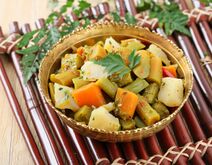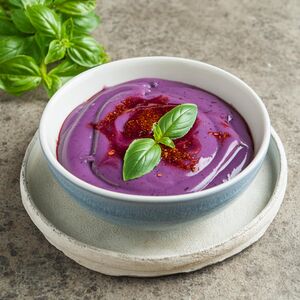Culture of Ohemia
Ohemian cuisine
Ohemian cuisine is the specific set of cooking traditions and practices associated with Federation of Ohemia, including the cuisines of Narsany-Targarat, Northern Ohemia, and the Kaspen Sea peoples, as well as some areas of Suria and Uherslent. Known for its unique blend of flavours, innovative cooking techniques, and a deep connection to its rich cultural heritage, Ohemian cuisine offers a distinctive culinary experience that reflects the region's history, geography, and traditions.
The cuisine of Ohemia has evolved over centuries, partially influenced by various cultures and civilisations that have settled in or traded with the region. From ancient agricultural practices to the introduction of exotic spices by traders, the culinary landscape of Ohemia has been shaped by a myriad of factors. The fusion of indigenous ingredients with foreign influences has resulted in a cuisine that is both eclectic and harmonious, celebrated for its complexity and depth of flavour. Generally, the cuisine is a central part of the cultural identity and social fabric. Meals are often communal affairs, bringing together family and friends to share in the bounty of the land. Festivals and celebrations are marked by elaborate feasts, where traditional dishes are prepared with great care and pride.
Side dishes & Accompaniments
In Ohemian cuisine, side dishes and accompaniments play a vital role in complementing the main courses, adding both flavour and texture to create a balanced and satisfying meal. These dishes are often simple yet rich in taste, showcasing the fresh and seasonal ingredients that Ohemia is known for.
Adaŕora Ǧamôr, meaning "Green Paste" in Ohemian, is used as a relish or spread to enhance a variety of dishes. This versatile condiment is made from a blend of finely mashed herbs, those being coriander, basil and mint, as well as olive oil and sometimes nuts or seeds, which gives it a rich and vibrant green colour. The flavour profile is typically fresh and zesty, with a hint of earthiness from the herbs. This green paste is also a favourite in vegetarian dishes, where it is mixed with roasted vegetables, stirred into grain salads, or dolloped onto soups and stews to provide a refreshing contrast. In the Kaspen Sea regions of Ohemia, it is traditionally served with fish, particularly grilled or poached varieties, to enhance the natural flavours of the seafood.
| Terčeni: Diced and picked vegetables with vinegar. | <image>
Rodčievec Terčen: Picked radishes with a vinegar glaze. |
<image>
Adaŕora Ǧamôr: Mashed coriander, basil and mint with some Olive oil made into a paste, similar to pesto. |
| Gūstemərvānā: Yoghurt with chives, garlic chunks
and garlic paste. |
Smôkmərvānā: Yoghurt mixed with sumac,
along with basil paste and a vinegar glaze. |
<image>
Gūste Mustačeniyāts: Garlic mustard. |
| <image>
Gindāgūste Ǧamôr: Paste of wild garlic (Allium ursinum) with dill. |
<image> | <image> |
Beverages
Alcoholic drinks
Alcoholic beverages are a significant part of the culture and social fabric, reflecting the country's rich history and diverse regional traditions.
Tre̊cličeni, literally meaning "Three Shots" is more of an appetizer containing some non-alcoholic elements as well, which are usually taken before eating food. It traditionally contains shots of Citrone Vodka, Olive Oil, and Cider Vinegar respectively, resonating closely to the Ohemian Phrase: "One for the heart, one for the soul, and one for the gut".
Cider or Sidrā is also somewhat popular in Ohemia, but most produce usually goes through a second fermentation process, hence Cider Vinegar or Zogordē. In North Ohemia, Nēnj Sidrā is a popular cider made from Oranges.
| <image>
Tre̊cličeni: "Three Shots", containing a shot of Citrone Vodka, Olive Oil, and Cider Vinegar. |
<image>
Jifron: Fermented milk mixed with some vodka. |
<image>
Vodcā: Vodka. |
| <image>
Nēnj Sidrā: A type of Orange cider. |
<image>
Stiraspirit: Moonshine made from fermented raisins. |
<image>
Piv: Beer, usually made with grains or hops. |

